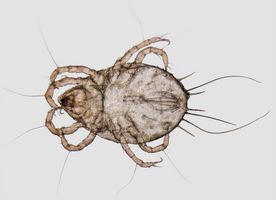Allergies in autumn? What is important for house dust mite allergy sufferers now
Mite alarm for the heating season: what's behind it?
When the pollen season ends, the mite season begins. As soon as the temperatures drop outside and we turn up the heating indoors, it's not just us who enjoy the comfort. House dust mites are now in their absolute peak season - autumn and winter are paradise for them! The dry, warm heating air makes the bedroom a hotspot. Mites feed on dead skin flakes, which we lose in bed, especially at night. For allergy sufferers, this often means itchy eyes, a blocked nose and restless sleep.
How many people in Europe are affected?
In Europe, around 10-20% of the population suffer from a house dust mite allergy - that's many millions of people, children and adults alike.
What other types of mites are there?
In addition to house dust mites, there are, for example, storage mites (such as flour mites), which can be found in food, and burrowing mites (sarcoptic mites), which can cause scabies. In everyday life, however, allergy sufferers are almost always bothered by house dust mites.
What happens with a house dust mite allergy?
Typical symptoms are a blocked nose in the morning, sneezing attacks, itchy and watery eyes, coughing and occasionally asthmatic complaints. The risk is particularly high in the bedroom, where many allergens are stirred up, as mattresses, pillows and duvets attract mites. Children's cuddly toys should not be forgotten either.
Why is the problem worse in autumn and winter?
Less ventilation and running heaters make the air drier, and mite particles and their allergens swirl up more. If you don't take active preventative measures now, you run the risk of persistent symptoms - prevention is particularly important during the heating period.
My everyday anti-mite plan:
- Use mite-proof encasing covers for mattresses, pillows and blankets
- Wash bed linen and covers every week at 60°C
- Ban carpets, open shelves and curtains from the bedroom
- Ventilate in the morning and evening, keep the room temperature below 18°C
- Use a hoover with HEPA filter for carpets/upholstery
- Allergy sufferers should ideally not vacuum themselves or wear a mask and ventilate the room
- Avoid humidifiers - mites particularly love moisture!
Practical tip: Put cuddly toys in the freezer!
Cuddly toys and sensitive pillows that cannot be washed hot can be put in the freezer for eight hours. The cold reliably kills mites and eggs. Shake them out well afterwards - this will make little allergy sufferers and their parents happy.
Expert tip: Encasing covers help
Mite-proof covers on mattresses, pillows and blankets significantly reduce contact with allergens. Put them on after every change - this brings back peaceful sleep.
Self-test: Am I affected by a house dust mite allergy?
- Do I often start the day with a blocked nose or sneezing?
- Do my eyes or palate itch in the morning?
- Do the symptoms get worse during the heating period?
- Do I have a cough, asthma or shortness of breath at night?
Do two or more statements apply to you? Then you should have an allergy checked by a doctor.
Conclusion: Small measures, big effect
It is never possible to get rid of mites completely. However, with the right washing habits, a freezing trick and encasing covers, you can significantly reduce your exposure - so you can breathe easy again in the cold season.
Go to news overview

